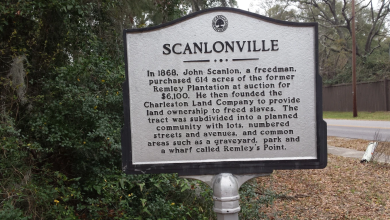1. Rain Bomb
The storm came from the southwest, loaded with moisture from the Gulf of Mexico. Gray clouds moved in with little warning, drizzling at first. Then just before noon *September 25 the skies opened up, unleashing a storm of disruption.
In two hours, more than 3 inches fell by Charleston’s medical district. At one point, it fell at a rate of 5.5 inches per hour. More than 3 inches fell on Daniel Island. Streets downtown turned into lakes. Waves rolled down Rutledge Avenue, taking a bumper with them. Draining water created vortexes by storm sewers that overflowed. Cars stalled as motorists tried to coax them through rising waters.
Charleston is no stranger to downpours, but these heavy storms are more intense and common now as the forces of climate change rev up.
This, in turn, poses new challenges:
Patients and health care workers here increasingly battle floodwaters to reach Charleston’s vulnerable medical district — or they give up altogether, costing hospitals millions of dollars.
Emergency crews here now train to pluck people trapped in their cars by rising water.
And people in poverty here often suffer the most, with some forced to flee low-lying homes and walk through fetid stormwater crawling with bacteria.
The Post and Courier’s Rising Waters project is documenting these immediate effects amid the accelerating forces of climate change. And the September 25 storm was a soggy reminder of how fast things can change.
The downpour closed out a week in which Charleston saw the Atlantic Ocean pour into many of its streets, pushed by abnormally high tides and other climate-driven factors that left the city flooded on a series of sunny days. But the September 25 drenching wasn’t just a nuisance. It was downright dangerous, damaging property, stranding motorists and swallowing cars whole.
2. Deluge
Deluge. Drencher. Frog-drowner. Whatever you call the September 25 storm, it had a slow arc.
It began days before when a piece of the jet stream broke off and drifted south. At the same time, the remnants of Tropical Storm Beta headed our way, then collided with a blob of moisture moving in from Georgia. Slabs of gray clouds built on September 25 as the sun rose.
At 7 a.m., the National Weather Service simultaneously launched 92 weather balloons across the country, including one from its office by the Charleston International Airport.
Filled with helium, the latex orb, 5 feet in diameter, rose above the Lowcountry. Tethered below the balloon was a radio transmitter. It recorded temperatures, wind speed and humidity levels — data that forecasters use to predict the weather. It climbed higher, documenting the blob of moisture and radioing back the results: The atmosphere held more than 2 inches of precipitable water. In forecasting terms, this was an unusually high amount of moisture over us for this time of year. It was a prelude to what happened next.
Just before noon it began to rain. And then it rained harder. Within an hour, it was clear this was going to be one of those disruptive events.
A cloudburst. Squall. Rain bomb.
Brown murky water quickly filled low streets in Charleston’s West Side — Line, President, Ashley, Fishburne. In no time, cars were sending up high sprays as floodwaters licked at their bumpers and police raced in to lock down impassable routes. Motorists were caught off guard, like one woman in a red Chrysler 300 with her daughter in the backseat.
The woman, who declined to give her name, said she was from out of town and visiting for an event at The Citadel. Her car had stalled at the intersection of Ashley and Sumter. “I see some bubbling, maybe it’ll go down?” she said, but ultimately she resolved to call a tow truck.
Around the corner, Anthony McNight, a Charleston native, was caught wading through a foot and a half of water as he carried home a plastic sack takeout lunch, his gray sweatpants and black boots soaked.
One of his trash cans had overturned in the tempest and the other had probably floated away, he said.
Have the floods gotten worse in recent years? “No doubt,” he said.
3. Enormous Power
South Carolina has always been a hothouse, a place where rain came heavy and hard. But a rapidly warming planet makes these extreme events more likely. Every 1-degree increase in temperature means the atmosphere can hold 4 percent more moisture. During the past 30 years, the atmosphere has warmed 1.3 degrees, NASA says. The hothouse is getting hotter.
When all this warm water vapor hits cold air aloft, it condenses and forms droplets. The drops fall as they get heavier. They combine with others on their way down and split when they get too large. Then they strike the ground like tiny bombs. Under microscopes, droplets make craters in dirt and sand. “Raindrops wreak havoc on Earth,” an Arizona State study said in 2007. “They just do it on a microscopic scale.”
Add all these raindrops, and you end up with flooding havoc. Add climate change, and it’s just that much worse.
Human-induced climate change made 2018′s Hurricane Florence about 5 percent wetter than it would have been otherwise, a study in Science Advances earlier this year found. It dropped a staggering 30 inches over some parts of the Carolinas. Same with Hurricane Harvey in 2017, which dropped more than 50 inches of rain on parts of Texas.
And the trend toward heavier storms is accelerating. Since 1958, the Southeast has seen a 27 percent increase in severe downpours, a recent NOAA analysis found. We saw an example in April when a storm soaked parts of Charleston with 5 inches in a matter of hours. And another in May, when a storm dumped 5 inches in a two-hour torrent.
And on September 25, by Gadsden Green homes, where streets turned into river rapids.
Gadsden Green is a public housing project known as Back Da Green. Samuel Hart was hard at work: pushing a stalled black Honda Accord onto the one island of dry land on Line Street, and then changing the tire of a black Ford Escape in front of it. Hart, who lived on nearby Allway Street, said he hadn’t had to push a car out of floodwaters in many years — but he liked jumping into action, because he hoped strangers would do the same for him if the situation were reversed.
After the tire was changed, he took a drag of a cigarette, flashed a wide grin and said, “Let’s see who else I can help,” before hopping on a bicycle.
The driver of the Escape, Ilaria Santini, reasoned she’d driven over something sharp in deep water along the way. A Rome native who lived in Goose Creek and worked at Boeing, she said she had never seen street flooding as bad before.
When the tire change was complete, she wondered whether to call back 911, which she had rung earlier, and tell them she was OK.
Hart and his friends agreed: “They ain’t coming anyway.”
4. Jet Stream
Something else is making these storms linger and dump more rain, a powerful river in the air 5 to 9 miles in the sky: the jet stream.
It swings west to east across the northern latitudes. It’s formed when warm air from the tropics meets colder and denser air from the Arctic.
There’s energy in this collision of hot and cold. The greater the temperature difference, the more energy. When the Arctic is colder, the jet stream flows faster, wiggling across North America like a freshly caught fish grasped with two hands.
But, because of climate change, the Arctic is warming two to three times as fast as the rest of the world. The temperature difference between north and south is less — less energy for the jet stream. It’s as if the atmosphere has loosened its grip on that undulating fish, allowing it to flap back and forth more slowly and dramatically.
“As the jet stream gets weaker and weaker, the stream tends to make these larger north and south swings,” said Jennifer Francis, a senior scientist with the Woods Hole Research Center. “And they tend to cause very slow-moving weather regimes.”
In some cases, the jet stream can bend as far south as Mexico, picking up moisture from the Gulf and then shooting it like a firehose in the Southeast, as it did in Louisiana in March 2016, dropping 20 inches of rain in some areas.
Or it can weaken, allowing lumbering storms in the South to linger. This happened on September 25, and it caught people across this suddenly waterlogged city by surprise, including Mandi Mezin.
She had driven from Atlanta to Charleston for a bachelorette party. Off Rutledge Avenue, she found herself surrounded by flooded streets. She drove onto a sidewalk to save her car. “I’ve never seen flooding like this,” she said.
Brian Walter, a UC Santa Cruz researcher studying flooding and inequality in North Charleston, surveyed the flooding downtown on his bike — safer than a car, because it wouldn’t stall in the waters on President Street.
“It’s frustrating and disappointing,” Walter said of the rain bomb’s handiwork. “It’s hard not to see it as a premonition.”
5. Another Storm
A lingering storm is a troublemaker. When the jet stream and other high-altitude winds are nearby, they blow the tops off thunderheads.
But when these high-altitude winds aren’t around, thunderheads form like popcorn kernels. Rising 5 miles and higher, they fill with ice crystals and water droplets. They might drop water below them in the form of a summer squall, but they need something else to do some serious damage, a trigger.
Like a tropical storm. When these forces collide, the ice crystals and water droplets smash into each other, generating electricity, and then this mass of energy and water falls, lighting the sky in inch-wide bolts that are so hot the air around them suddenly explodes, creating thunder.
Kenneth Kunkel, a scientist at the North Carolina Institute for Climate Studies in Asheville, and his colleagues studied data from 3,104 U.S. weather stations and recently came up with a surprising discovery about these extreme weather events.
They looked at precipitable water levels in the atmosphere. Imagine a column of air from the ground to the sky. Precipitable water is a measure of how much water vapor in that column can turn to rain.
But Kunkel and his colleagues found that the precipitable water measurement only went so far. In an extreme event, water vapor rapidly condenses and falls as rain, releasing energy in the form of heat. This extra heat adds more fuel to storms, whisking more water vapor into the tempest. It creates a powerful cycle, and soon everything below is sopping wet.
Kunkel’s study found that extreme rain events turbocharged the water vapor so much that twice as much rain fell as the precipitable water measurement. And that as the climate warms and holds more moisture, storms could have 15 to 25 percent more rain.
For people caught in the September 25 downpour, immediate needs trumped these larger trends.
Dane Rebang, 28, stood at America and Amherst streets on Charleston’s East Side waiting for an Uber ride to take him to work on Daniel Island after his low-riding car got swallowed in the flood.
He’s lived on the street for two years and knows storms can turn the neighborhood thoroughfare into a water-filled canal in no time. But he was taking a nap when the rain started Friday, and in less than an hour the street outside his apartment was knee-deep in water.
“Now I’m left standing here in staph water because my car is underwater,” he said.
All across the East Side, main streets and side routes became impassable, creating a frustrating game for harried drivers who tried to find a dry route through the flooded maze. Again and again, they passed by the waterlogged hulks of cars whose drivers tried a similar tactic, only to be left soggy and stranded.
Terry Jenkins chose to stay put. He sipped a beer on a relative’s porch at North Hampstead and Aiken streets, watching dirty water topple trash cans and fill the intersection like a basin. Jenkins, 61, recalled his mother telling him as a child to avoid the water or he’d get worms. He and his friends played in it all the same, and somehow avoided the fate his mom had predicted.
But he’s not sure what’s in the water these days, and it floods a whole lot more in the neighborhood than when he was young.
“The water gets higher, too,” he said. “It’s just worse these days.”
But days like September 25 will only grow more frequent as a warming climate adds more moisture above us.





Leave a Reply
You must be logged in to post a comment.